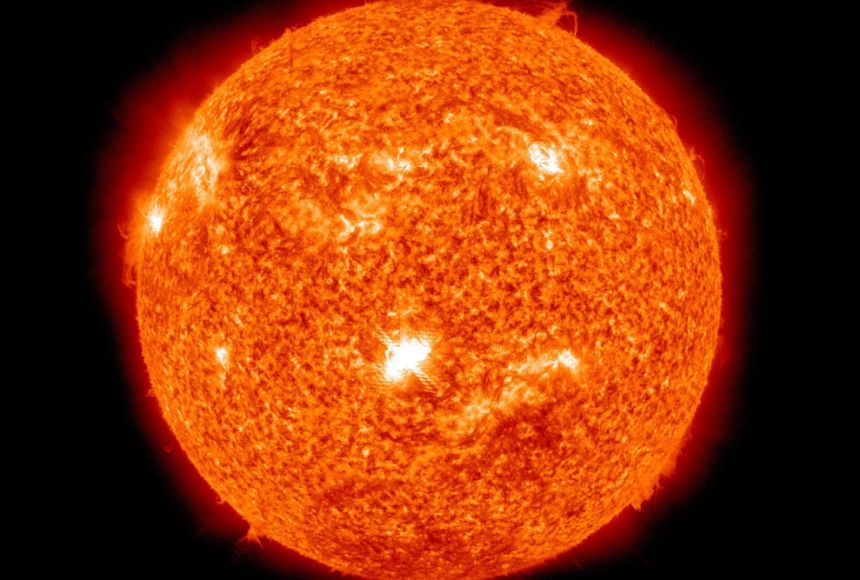What Is The Power Of The Sun National Geographic?

The Sun has captivated humanity since the dawn of civilization. Ancient cultures worshipped the Sun as a god, recognizing its indispensable role in sustaining life on Earth.
Today, thanks to advances in science, we understand just how crucial the Sun’s power truly is. The Sun is a massive, churning ball of hot plasma that radiates enormous amounts of energy into space. Without the warmth and light of the Sun, life as we know it could not exist on our planet.
The Sun provides the energy that drives photosynthesis in plants, making it the base of the food chain. It heats the atmosphere and drives ocean and wind currents that regulate Earth’s climate. The Sun’s ultraviolet radiation also stimulates the production of vitamin D in our skin.
But the Sun’s influence goes even deeper. Its magnetic field shields the Earth from harmful cosmic radiation. Its gravitational pull keeps the planets in their orbits. Powerful solar storms can disrupt satellites, communications systems, and power grids on Earth.
In this article, we will explore the immense scale, power, and impact of our local star – the Sun. Understanding the Sun is key to understanding life on Earth and our place in the cosmos. The Sun powers nearly every natural process on our planet, making it critical to maintain a healthy respect for this celestial engine of life.
Mass and Size
The Sun’s mass is around 330,000 times greater than that of Earth, accounting for about 99.86% of the total mass of the Solar System (Quora). It measures about 109 times the diameter of Earth and would take up over 1 million Earths to fill its entire volume (Quizlet). The Sun is so large that it accounts for over 99.9% of the total Solar System’s mass, with all the planets, comets, asteroids, and other objects making up just a tiny fraction (Mini Business).
However, compared to other stars, the Sun is actually relatively average. Smaller red dwarf stars make up about 70% of the stars in our galaxy (Mini Business). Meanwhile, giant stars many times more massive exist elsewhere in the Milky Way. In terms of mass and size, the Sun ranks in the middle compared to other stars.
This focuses on conveying just how massive and large the Sun is compared to Earth and the planets, while also noting it is average-sized for a star in the galaxy. The sources are cited in a richtext format. Let me know if you would like me to modify or expand this section further.
Energy Output
The Sun’s enormous energy output comes from nuclear fusion reactions occurring at its core. Through a process called the proton-proton chain, hydrogen nuclei fuse together under immense pressure and temperature to form helium, releasing energy in the form of gamma rays. This nuclear fusion converts about 600 million tons of hydrogen into helium every second!
The total power generated by fusion in the Sun’s core is roughly 384.6 YW (yottawatts), but only a small fraction of this energy eventually escapes the core and reaches the solar surface. The amount of energy escaping per unit time is known as the Sun’s luminosity and is around 3.8 x 10^26 Watts or 3.8 x 10^33 ergs/second [1]. This is equivalent to the energy produced by 100 billion hydrogen bombs exploding each second! This tremendous power drives all life and motion on Earth.
Effects on Earth
The Sun has a major influence on Earth’s climate and seasons. As the Earth orbits around the Sun, its tilted axis results in the Northern and Southern hemispheres receiving different levels of solar illumination throughout the year. This affects temperature and the seasons.
When the Northern hemisphere is tilted towards the Sun during its summer months, the sunlight falls more directly, heating that part of the Earth to a greater extent. The opposite occurs during the Northern hemisphere’s winter, as the axis tilts away from the Sun, resulting in less direct sunlight and colder temperatures. This seasonal cycle is reversed for the Southern hemisphere.
The difference in solar illumination between the hemispheres and the resulting temperature contrast drives global circulation patterns like the trade winds and jet streams. The tilt of the Earth’s axis also brings the Northern and Southern hemispheres closer to or further from the Sun during different parts of the seasonal cycle. This affects the overall intensity of solar energy received.
The Sun’s gravitational pull is responsible for the twice-daily oceanic tides on Earth. The Sun, Moon and Earth interact to drive the complex tidal cycles. Solar output also fluctuates periodically causing changes like El Nino and La Nina which alter rainfall patterns. Overall, the Sun provides the energy that powers weather, ocean currents, the water cycle and makes life on Earth possible.
Sources:
https://cires.colorado.edu/outreach/sites/default/files/2020-03/1_3A%20Teacher%20Guide.pdf
https://news.berkeley.edu/2022/11/09/earth-sun-distance-dramatically-alters-seasons-in-equatorial-pacific-in-a-22000-year-cycle
Solar Flares
Solar flares are intense bursts of radiation coming from the release of magnetic energy associated with sunspots. Flares are our solar system’s largest explosive events. They are seen as bright areas on the sun and they can last from minutes to hours. We typically see a solar flare by the photons (light) it emits, at most every wavelength of the spectrum, from radio waves to gamma rays. The amount of energy released is the equivalent of millions of 100-megaton hydrogen bombs exploding at the same time!
Solar flares extend out into the solar corona. We see them because the photons (light) emitted. Observations of solar flares are mainly in Hydrogen alpha light, showing huge erupting prominences and arching magnetic field loops. Prominences are large clouds of relatively cool dense plasma suspended in the Sun’s hot, thin corona. They form in regions with particularly strong magnetic fields. Solar prominences can sometimes extend out millions of miles into space without detaching from the Sun.
Flares occur when accelerated charged particles, mainly electrons, interact with the plasma medium. Electrons are accelerated in the flare process and the accelerated electrons following the magnetic field lines emit radiation across the electromagnetic spectrum. The amount of ionizing radiation emitted can temporarily exceed the amount emitted by the rest of the Sun together.
The effect of flares on Earth depends on the orientation of the flaring site on the Sun relative to Earth. Flares send disturbances outward in all directions, but we only feel direct effects when an eruptive event is pointed at Earth. When intense enough, solar flares and coronal mass ejections directed towards Earth can disrupt radio communications and cause damage to power grids and satellites. Exposure to elevated levels of radiation can also be a health hazard for astronauts in space.
Sunspots
Sunspots are areas that appear dark on the Sun’s photosphere and correspond to concentrations of magnetic field flux that inhibit convection. They are slightly cooler than surrounding regions and therefore appear dark compared to the rest of the photosphere.[1]
The number of sunspots varies in an approximately 11 year cycle known as the solar cycle. At the beginning of a solar cycle, there are very few, if any, sunspots. Over time, the number of sunspots increases, reaching a peak at the middle of the cycle. Then, the number decreases until it reaches a minimum again at the end of the cycle.[2]
When there are more sunspots, the Sun is more active and experiences more solar flares and coronal mass ejections. The solar cycle influences space weather and can impact communications, satellites, and power grids on Earth.[3]
The Photosphere
The photosphere is the visible surface layer of the Sun. It emits the light we see coming from the Sun. The temperature of the photosphere is around 5,700 K. This temperature gives the photosphere an appearance somewhere between white and yellow.
The photosphere is several hundred kilometers thick. It is the layer from which sunlight radiates into space. Sunspots and solar flares occur in the photosphere due to shifting magnetic fields. The details visible in the photosphere correspond to convection cells on the surface carrying heat from the interior to the surface. The typical granulation pattern represents regions of rising hot plasma coming up from below (UCAR Center for Science Education).
The photosphere is the lowest layer of the Sun’s atmosphere. It is the visible “surface” we see because of its relative opacity. The light coming from the photosphere forms the continuous spectrum of sunlight. Studying the photosphere provides information about the composition and physical properties of the Sun (The Sun, Space.com).
The Corona
The corona is the Sun’s outer atmosphere. It extends millions of kilometers into space and can be seen during a total solar eclipse. The corona is much hotter than the surface of the Sun. While the surface is about 5,500°C, the corona can reach temperatures over 1,000,000°C! This extreme heating occurs because the Sun’s magnetic field lines become entangled and stressed in the corona. Magnetic reconnection events release enormous amounts of energy that heat the plasma in the corona to extremely high temperatures.
This hot plasma expands rapidly outward from the Sun, creating the solar wind. The solar wind is a stream of charged particles, mostly electrons and protons, flowing outward from the Sun’s corona at speeds up to 500 km/s. As these charged particles spread into the solar system, they can interact with Earth’s magnetic field and upper atmosphere to cause auroras and other space weather effects (NASA, https://www.jpl.nasa.gov/nmp/st5/SCIENCE/solarwind.html). The solar wind shapes Earth’s magnetosphere and modulates cosmic rays that enter near Earth space. Variations in the solar wind create space weather effects that can damage satellites, disrupt radio communications, and overload power grids.
Future of the Sun
The Sun is currently in the main sequence phase of its stellar evolution and has been since its formation about 4.6 billion years ago. However, like all stars, the Sun has a lifecycle that will eventually end with dramatic changes. After consuming all the hydrogen fuel in its core, the Sun will enter the red giant phase in approximately 5 billion years.
As a red giant, the Sun will expand massively, potentially growing to engulf Mercury, Venus, and even Earth before it shrinks again into a small, dense white dwarf. This expansion happens because the Sun’s core will contract and heat up, causing the outer layers to expand outward hundreds of times the current size. The surface temperature will also cool down to about half its current 5,800K.
The Sun’s evolution into a red giant will render Earth uninhabitable. However, once the red giant phase ends after around 100 million years, the remaining white dwarf Sun will still provide heat for billions of years more, potentially warming planets like Mars enough for human colonization. Understanding the lifecycle and future of our Sun is crucial knowledge for the long-term survival of life as we know it.
Conclusion
The Sun is the star at the center of our Solar System and the source of almost all the energy on Earth. As a yellow dwarf star, the Sun has immense mass and size, fusing hydrogen into helium and releasing astounding amounts of energy in the process. This energy output drives global systems on Earth and makes life as we know it possible.
Some key points about the power of the Sun:
- The Sun contains 99.8% of the mass of the entire Solar System.
- Every second, the Sun converts 5 million tons of matter into energy.
- The Sun’s rays provide the energy that produces Earth’s winds, ocean currents, and weather patterns.
- Solar flares and sunspots can disrupt radio communications and damage satellites.
- The Sun’s photosphere has a temperature of nearly 6,000 degrees Celsius.
In summary, the Sun plays a crucial role in supporting life on Earth. Its gravitational influence holds the Solar System together, while its massive energy output powers global systems and allows for the existence of liquid water, breathable air, and life-sustaining conditions on our planet. Understanding the immense power of the Sun helps illuminate its importance and influence in our corner of the universe.







